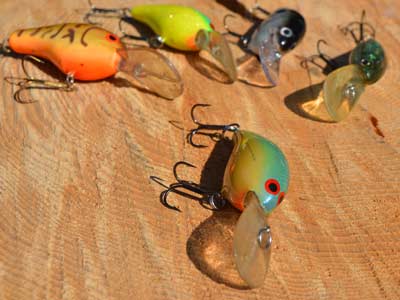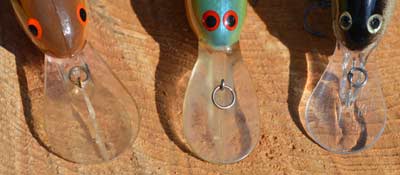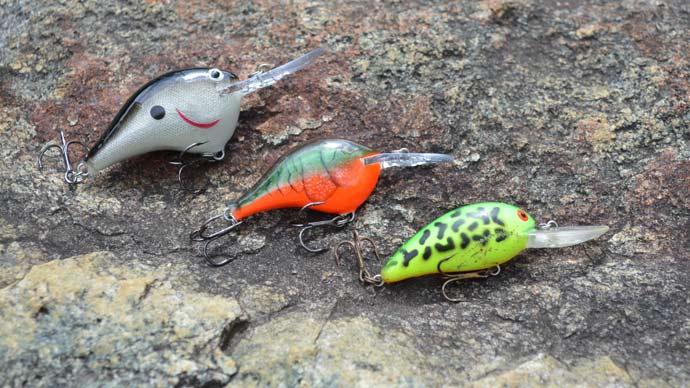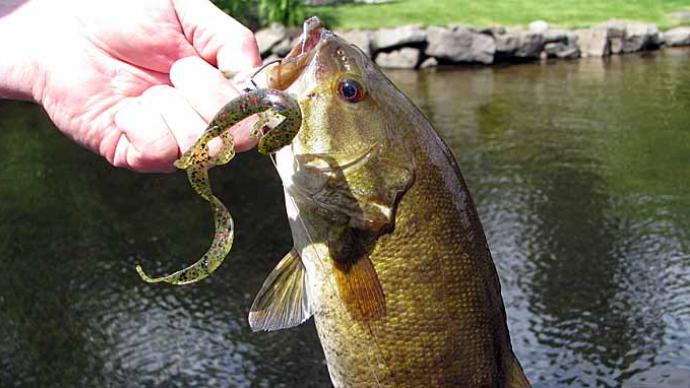
September's changes are palatable, especially if you're a bass angler. Still, mornings weighed down by heat and humidity are replaced with the freshness of crisp air and slight breezes. Passing weather systems, including hurricane remnants, stir the environment, bringing precipitation that pushes current and raises water levels.
Bass feel these changes, too. And it doesn’t take them long to respond, heading toward shallow water and putting on the feedbag. Anglers in the know take advantage by picking up a crankbait. These billed baits are one of the best options for covering water, mimicking baitfish, and setting off reaction strikes. All three are important to catching more and bigger bass in September.
But not any crankbait will do. You’ll need a medium-diver. They’re the perfect size to mimic the smaller baitfish that bass target in fall. And they dive to the perfect depth, catching fish that lipless crankbaits usually go over. And they don’t produce the resistance that makes cranking deep divers a chore.
Catching the most and biggest bass with a medium diver takes preparation. First, you need to choose one that has the best characteristics. Then you need to fish it to its potential. Finally, you have to put it in the right spots. Here’s how to do all three.
Pick The Best Crankbait
Crankbaits sporting stubby bills barely break the surface, regardless of how fast you retrieve them. And a grinding retrieve sends ones with bills longer than their bodies to depths that light hardly reaches. Both fill essential places in your tackle box. But when the calendar turns to September, you want one that finds just the right depth. That’s a medium-diver.
Medium-divers come in a variety of shapes and colors, as all crankbaits do. They’re easy to identify by their bill. It’s about the same length, sometimes slightly shorter, than the crankbait’s body. And it juts straight out or a few degrees down. That configuration accomplishes a couple of things. First, the bill orients down during the retrieve, acting as a hook guard. That allows you to bring your crankbait through laydowns, rocks, and other cover with fewer snags. It also digs down just enough, putting your lure in the perfect early fall depth range — 5 to 12 feet.
Image
While the length of a crankbait’s bill determines its diving depth, its shape is important, too. Choose a rounded one, which will roll your crankbait around the cover it encounters, leading to fewer snags. Photo by Pete M. Anderson While a deep-diving crankbait will consistently reach that depth range, its extra pull puts unwanted — and unneeded — pressure on you. A medium-diver won't magically reach that depth by simply cranking. You'll need to coax it along to get there cast after cast. You can do four things to ensure it consistently reaches the cover, structure, or bottom you want to bump to encourage a bass to strike.
- Use a thin diameter line: The larger a line’s diameter, the more water resistance it creates, and the shallower your crankbait runs. So, choose a thin-diameter line such as 8- to 12-pound test fluorocarbon. But that trait isn’t always related to pound test. Braid, for example, is much thinner than equal strength monofilament line.
- Point your rod down: Bass tournament legend Paul Elias was onto something with his kneel-and-reel technique, though you don’t have to match his zeal. Simply putting your rod’s tip at or near the water’s surface helps your crankbait dive to its maximum.
- Slow your retrieve: Speedy retrieves usually cause crankbaits with longer bills, such as medium-divers, to spin out and lose diving depth. A slow to medium retrieve, on the other hand, allows the bill to do its job, digging and forcing your crankbait deeper.
- Swap out hooks: Switching to larger hooks — size or wire thickness — adds weight to your crankbait, causing it to suspend or slowly sink. Removing buoyancy will add to its diving depth, though it's risky. Too large of a hook can kill action and snag more often.
Getting your crankbait to where the bass swim is the first step. Next, you need it to perform. While some medium-divers are available with an angled coffin-style bill, choose the more popular rounded style instead. When your crankbait contacts a rock, log, or other piece of hard cover on the bottom, the bill will roll it around the obstruction. That means fewer snags. And choose a rounded body. The water is still relatively warm in September, regardless of where you’re fishing. So, the exaggerated wobble it produces will be more attractive to bass than the tighter one produced by flat-sided crankbaits.
Identify The Best Situations
Versatility is a word that’s often applied to bass-fishing lures. And it’s on target when it comes to medium-running crankbaits. They can cover a range of depths and pick their way through many types of cover. They make you a versatile angler. But even the best anglers won’t catch a bass if there aren’t any around.
After a summer hanging around deep-water structure or tucked into the thickest shallow-water cover, bass are on the swim in September. Most are in pursuit of baitfish, whether shad down South or yellow perch up North. They are headed shallow, where conditions are improving. And chances are, you'll find bass in the 5- to 12-foot range wherever you're fishing. And that's perfect for throwing a medium-running crankbait.
There's plenty of water that deep in most reservoirs, rivers, and lakes. So, to whittle it down to the best, focus on these three variables:
- Depth change: Bass use abrupt depth changes — those spots on your mapping where contour lines almost touch — year-round. But small 2- to 4-foot ones are perfect in September. Bass use them as ambush points when feeding and for quickly sliding shallower or deeper as conditions change.
- Hard cover: In many waters, aquatic vegetation may still be going strong in September. But with less daylight and cooling water temperatures, bass are drawn to hard cover such as wood, rocks, and docks. It may be mixed with aquatic vegetation, but the best spots always have some around.
- Current: It's time to stir things up after a long hot summer. Whether created by inflow from autumn rain or wind blowing in a front, some additional current will make bass bite by stirring the food chain or adding water color. Even a tiny amount of current will make one spot better than all the others.
Very few spots offer all three variables. While you won’t want to bypass the ones that do, spend your time cranking those that have at least two. They’ll attract enough bass to keep you busy.
Choose The Best Spots
The above variables aren’t unique to a body of water. Each can be found in reservoirs, natural lakes, and rivers. Here are three spots where these traits are usually found on each type of water body.
Reservoirs
These manmade bodies of water are where crankbait fishing was born. Cover plays a secondary role to structure when searching for bass. Focus your fishing on the upper third, where you often find the main river and plenty of shallow water.
- Main-lake coves: These are some of the first spots bass stop as they make their way back to shallow water after spending all summer in deep water. Concentrate on ones near creek arms, searching out any cover within them.
- Secondary points: These small points are the same ones prespawn bass use during spring movements. The best ones offer a second structure element, such as a creek channel swing. Crank any cover that you can find where the two meet.
- Main river: Go upstream until you find a well-defined channel that sports expansive flats on either side. Look for pieces of isolated cover such as logs, bridge abutments, and points wrapped in riprap. You'll have to cover water to crank each, but all have the potential for a big bite.
Natural Lakes
Image
Crankbaits work best when they reach their maximum diving depth. Ensure your medium-diver gets there by using a thin diameter line. It has less water resistance, allowing your crankbait to dive deeper. Photo by Pete M. Anderson Often home to a mix of smallmouth and largemouth and a healthy spattering of aquatic vegetation, these water bodies aren’t the first place most bass anglers think of casting a crankbait. But each has spots ripe for picking apart with a medium-diver, especially in September.
- Inside edges: Head to the shallow side of aquatic vegetation beds, especially where they run along a rock-covered flat or bank. Run your crankbait along the edge so it’s always in the strike zone. Key on points and pockets along the edge or where cover, such as a boat dock or log, intercept it.
- Flats: Baitfish cruise the consistent depth of these pieces of structure, chasing their suspended microscopic meals. And bass are never far behind. While the edges are worth some casts, search out isolated cover, such as a small rock pile, single log, or boat-mooring anchor, on the flat itself.
- Shoals: Pick your way around the outside of these high spots, which are most often found a ways away from the bank. Look for where the drop-off is steeper or bottom composition changes. And as on flats, let the wind guide you; most days, the windward side is best.
Rivers
Winding through the countryside, most anglers bypass small and mid-sized rivers in favor of lakes and reservoirs. But they’re home to large populations of bass, though they may not reach the same size as their still-water counterparts.
- Riprap banks: These rocky stretches are bass magnets, especially when the water temperature is cooling. Aim your casts at the ends and any points or pieces of cover you encounter along the length. While you'll get some bites fishing end to end, you'll be more efficient by only hitting the high points.
- Laydowns: Many line the bank, and they hold bass year-round. But certain stretches are better in September. Key on those at the start and end of the outside bank of each turn, where the deepest water is often found. And be sure to work your medium-diver through the deepest branches.
- Backwaters: Most river bass will winter here, where there's less current and deeper water than the main river. The typical ones have plenty of hard cover and a bottom well within reach of a medium-diver. Fish the mouth early in September, moving toward the back as October nears.




